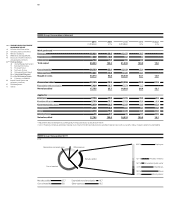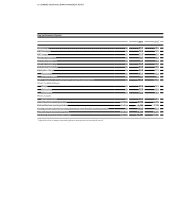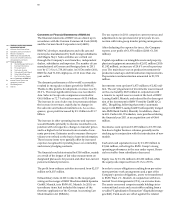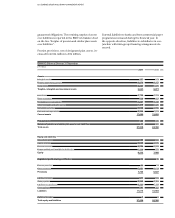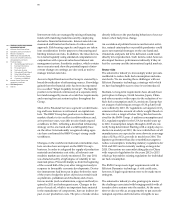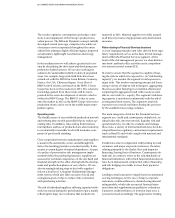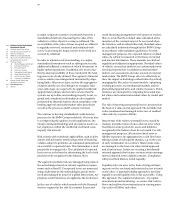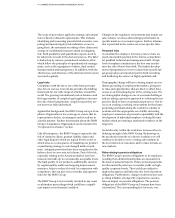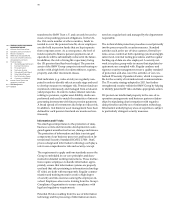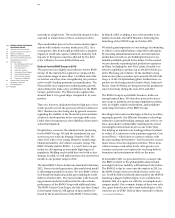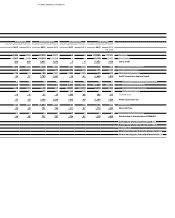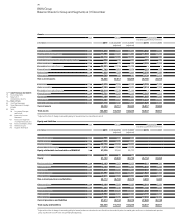BMW 2011 Annual Report Download - page 69
Download and view the complete annual report
Please find page 69 of the 2011 BMW annual report below. You can navigate through the pages in the report by either clicking on the pages listed below, or by using the keyword search tool below to find specific information within the annual report.69 COMBINED GROUP AND COMPANY MANAGEMENT REPORT
The need to optimise consumption and reduce emis-
sions
is an integral part of the Group’s product inno-
vation process. The Efficient Dynamics concept, initially
developed several years ago, comprises the whole set
of
measures now incorporated throughout the entire
vehicle fleet relating to highly efficient engines, improved
aerodynamics, lightweight construction and energy
management.
In the medium term we will achieve greater fuel econ-
omy by electrifying the drive train and developing com-
prehensive hybrid systems. We are also working on
solutions for sustainable mobility in densely populated
areas. For example, large-scale field trials have been
carried out with the MINI E in Great Britain, Germany,
France, the USA, China and Japan. A test fleet of
BMW ActiveE electric cars based on the BMW 1 Series
Coupé
has been on the roads since 2011. The extensive
knowledge gained from these trials will be incor-
porated in the series development of electric vehicles
within the BMW Group. The BMW i 3 is due to come
onto the market in 2013 as the BMW Group’s first series
production electric car for use in the world's major metro-
politan
regions.
Operating risks
The flexible nature of our worldwide production network
and working time models generally helps to reduce op-
erating risks. In addition, risks arising from business
interruptions and loss of production are also insured up
to economically reasonable levels with insurance com-
panies of good credit standing.
Close cooperation between manufacturers and suppliers
is usual in the automotive sector, and although this
form of networking provides economic benefits, it also
creates a certain degree of mutual dependence. As part
of a policy of preventative risk management imple-
mented
within the purchasing function, suppliers are
assessed for technical competence on the one hand and
financial strength on the other, during both the develop-
ment
and production phases of our vehicles. We are
also increasingly taking steps to deal with suppliers’
risks at a local level. A Supplier Relationship Manage-
ment system, which also takes account of social and
ecological aspects, helps to reduce risks connected
with
purchasing activities.
The risk of individual suppliers suffering capacity bottle-
necks increased during the period under report, mainly
reflecting the huge rise in volumes that needed to be
mastered in 2011. Material supplies were fully assured
at all times by means of appropriate early-intervention
measures.
Risks relating to Financial Services business
A set of strategic principles and rules derived from regu-
latory requirements serves as the basis for risk manage-
ment within the Financial Services segment. At the
heart of the risk management process is a clear division
into front- and back-office activities and a comprehen-
sive internal control system (ICS).
In order to ensure that the segment is capable of bear-
ing the risks to which it is exposed (i. e. its “risk-bearing
capacity”), we monitor the segment’s total exposure to
major risks. This involves measuring unexpected losses
using a variety of value-at-risk techniques, aggregating
those losses (after factoring in correlation effects) and
comparing the aggregated result with resources avail-
able to cover risks (i. e. equity). The segment’s risk-bear-
ing capacity is monitored continuously with the aid of
an integrated limit system. The segment’s total risk
exposure was covered at all times during the past year
by the available risk-coverage volumes.
The main categories of risk for the Financial Services
segment are: credit and counterparty default risk, re-
sidual value risk, interest rate risk, liquidity risk and
operational risks. In order to evaluate and manage
these risks, a variety of internal methods have been de-
veloped based on regulatory environment requirements
(such as Basel II) and which comply with national and
international standards.
Credit risks arise in conjunction with lending to retail
customers and major corporate customers, the latter
relating primarily to the dealer, fleet and importer
financing / leasing lines of business. Counterparty de-
fault risk, by contrast, refers to the risk that banks or
financial institutions with which financial instruments
have been transacted in conjunction with refinancing
and risk hedging are unable to meet their payment
obligations.
Lending to retail customers is largely based on automated
scoring techniques. In the case of major corporate
customers, creditworthiness is checked using internal
rating models, which take account of financial state-
ment data and supplementary qualitative evaluations.
Customer creditworthiness is tested at least once a
year
and revised accordingly. The approval for lending



